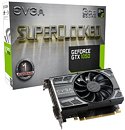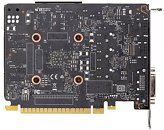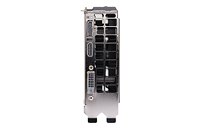Friday, June 29th 2018

EVGA Introduces Its GeForce GTX 1050 3 GB Graphics Cards
EVGA announced the market availability of a "vanilla" GTX 1050 3 GB graphics card (the Gaming 03G) and its SuperClocked variant (the SC Gaming 03G). They both carry the same 768 CUDA cores. Clocks for the Gaming 03G are NVIDIA reference (1392 MHz base, up to 1518 MHz boost, 3 GB of 7008 MHz GDDR5 memory across a 96-bit memory bus), and the SuperClocked version brings the core clocks up to 1455MHz and 1569MHz (base and boost, respectively).
The graphics cards come in a short form factor (144.78mm x 111.15mm) - a simple, single-fan cooling solution is more than enough to cool down the GPU, which only needs PCIe power to function correctly. Display outputs are set at 1x dual-link DVI-D, 1x DisplayPort 1.4, and 1x HDMI 2.0. The Gaming 03G version is available for $159.99, while the SuperClocked version comes in at $169.99. Both feature a three-year warranty.
Source:
Tom's Hardware
The graphics cards come in a short form factor (144.78mm x 111.15mm) - a simple, single-fan cooling solution is more than enough to cool down the GPU, which only needs PCIe power to function correctly. Display outputs are set at 1x dual-link DVI-D, 1x DisplayPort 1.4, and 1x HDMI 2.0. The Gaming 03G version is available for $159.99, while the SuperClocked version comes in at $169.99. Both feature a three-year warranty.





24 Comments on EVGA Introduces Its GeForce GTX 1050 3 GB Graphics Cards
The overall product however, still feels odd. I mean, EVGA is something you expect enthusiasts to buy, whereas 1050 is meant for those that don't care (or need) much. But hey, if EVGA feels there's a market for these, who am I to argue?
If that is the case then manufacturing costs should be lower, and therefore the market price.
According to the survey, the 1060 is the most popular card in May. The 1050/TI make up slightly more percentage if you count them together. The 960 still holds a respectable 5% though.
I would be this new GTX1050 with 96-bit bus but with all the shaders unlocked, probably is limited by the memory bus. However, that is what nVidia wanted, so it wouldn't compete with the GTX1050Ti. I haven't seen any performance numbers on these new GTX1050s but I'm guessing their performance is actually going to be closer to a GTX1050Ti instead of a GTX1050 2GB.
You can totally change the bandwidth of a data transmissions by using a controller that say only reads the data lines each 2 cycles, therefor you can have a bus that's used "100%" but where the resulting bandwidth is half of what it can be because of the controller. And this can happen the other way around as well. Your thinking is flawed because you assume that the controllers are always as fast or slower than what they would need to be for a specific bus/clock combination.
An obvious sign that controller load is independent from the default bus/frequency configuration the fact that you can overclock the memory and it will all still function correctly. Sure the controller may only be wired for 32 data lines but that doesn't mean it can't be faster than that and therefor report lower utilization. Bus load =/= memory controller load otherwise why would there even be a distinction between the two in the first place , come on man. :laugh:
As for your overclocking, AFAIK, the memory controller and memory bus all get clocked to match the memory. That is why different GPUs that are paired with the exact same memory often reach different memory clock speeds. One of the memory controllers is becoming unstable before the actual memory is. And some memory controllers are built better than others and can handle the higher clock speeds.